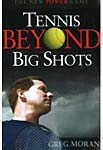| TennisOne Lessons Put Together Your Playbook Greg Moran As you work on your tennis and move up the NTRP ladder, you’re going to reach a level of play where the majority of your points are no longer handed to you.
Now, I apologize in advance to any of you that find my next statement offensive however, I’ve been teaching tennis for well over 30 years and feel quite confident when I say that: The majority of tennis matches at the 3.5 level and below are a race to see which player or team can miss enough shots to lose the match first. 3.5 level tennis is often characterized by impatient players, armed with turbo-powered racquets, biding time until they can tee it up and go for their next big shot. This approach usually results in a string of impressive looking (and sounding) errors ending only when one side misses enough shots to lose the match. This approach, often called “hit bit to win big” in my opinion is better termed “hit big to lose quickly.” Experienced players have learned that one big (low percentage shot) will not get the job done against upper level players. Players at the 4.0 levels and above do not hand their opponents free points and one big shot will seldom break them down. To win against the big boys and girls requires patience, discipline and a game plan.
In high level tennis, the players that can impose their game plan most effectively will usually win the match. Just as the New York Giants or Boston Celtics have a book of plays that they run during their games, you need to put together a mental playbook that you can use during your matches. These plays are called patterns. Simply put, a pattern is a predetermined sequence of two or more shots that you combine to begin dictating the point. They can be used when serving, receiving and during rallies throughout every point you play. Here are a few patterns to try the next time you take the court against a tough opponent. Serving Patterns As you toss the ball have two shots planned: your serve and your response to your opponents return. Here are three serving patterns that will be effective against any opponent:
Return of Serve Patterns
Your goals when returning serve are to first, get the ball back in play and second, take away the server’s advantage. To do so, focus on these three patterns.
A favorite pattern of mine is to hit a drop shot off my opponent’s second serve. They seldom expect it, usually struggle to reach it and, more often than not, meekly pop it back over the net. I’ve then got an easy passing shot or I can torture them with a lob over their heads.
Baseline Patterns As you and your opponent are exchanging neutral groundstrokes, wait for a ball in your strike zone, step into your shot and take control of the point by using one of these patterns.
Another favorite of mine is, when I find myself trading backhands with my opponent, I like to hit three deep crosscourt shots and then throw in a down the line drop shot. As they scramble forward to get it, I’ve already got my point-ending lob planned.
Doubles Patterns Few things feel better in doubles than when you and your partner execute a patterned play to perfection. When your team is serving:
When your team is receiving:
Stay Away from Bad Patterns As you try to impose your patterns of play onto your opponent, he’ll undoubtedly be doing the same. Learn to recognize your opponent’s patterns and try to break them. For example, my forehand is my weakest shot. Everyone I play against knows it and does their best to get me in a cross-court forehand exchange during the point. Knowing my weakness, as soon as I recognize my opponent moving into a forehand to forehand pattern, I immediately break it by hitting a high ball down the line to their backhand. They usually return the ball crosscourt to my backhand at which point I can begin to work my backhand to backhand pattern; my favorite. Patterns Are Your Game Plan For Victory
The number of patterns you can come up with are endless. While you’re in front of the television, daydreaming at your desk, or waiting in traffic, think of some creative shot combinations. Take them to the court with you and give them a try. By coming up with two or three simple patterns from each area of the court and learning to execute them well, you’ll often be able to dictate play and ultimately move in for the kill. High level tennis has frequently been compared to chess and the description is well deserved. By devising and implementing your patterns you’ll be well on your way to checkmating your opponent. Your comments are welcome. Let us know what you think about Greg Moran's article by emailing us here at TennisOne.
Tennis Beyond Big Shots presents a bold back-to-the-future approach. A new game that moves away from power and big shots yet is more lethal to opponents than any booming serve. Greg Moran shows players of all ages and abilities that, with simple and small changes, you can not only maximize your tennis wins and play longer, but also have much more fun doing it. Click link to purchase Greg Moran's book, Tennis Beyond Big Shots. |
